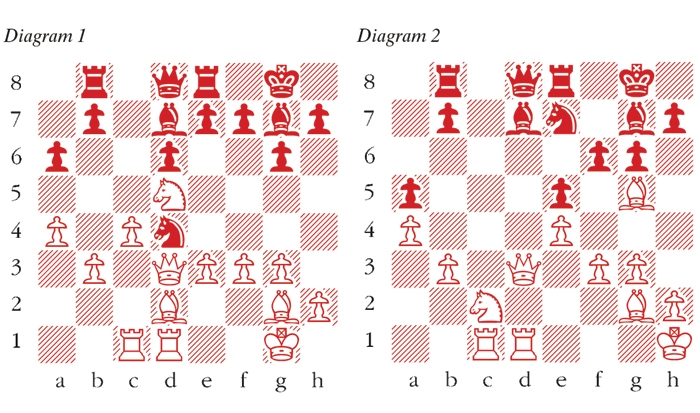As the new year begins, I pay a final tribute to the city financier Jim Slater, who did so much to support British chess and who was instrumental, with Henry Kissinger, in rescuing Bobby Fischer’s challenge against Boris Spassky from Reykjavik 1972. Slater offered £50,000 to increase the World Championship prize fund, created awards and prizes for the first British grandmasters (of which I was a grateful recipient) and sponsored tournaments to promote British chess. This new year column celebrates Jim Slater’s first foray into sponsorship of chess. He died towards the end of 2015.
Keene-Whiteley; Slater Tournament, Southend 1968; English Opening
1 c4 c5 2 Nf3 Nc6 3 Nc3 Nf6 4 g3 g6 5 d4 cxd4 6 Nxd4 Bg7 7 Bg2 0-0 8 0-0 Nxd4 9 Qxd4 d6 10 Qd3 Rb8 More popular these days is 10 … Nd7. 11 Bd2 a6 12 a4 Be6 13 Rac1 Ng4 14 b3 Ne5 15 Qb1 Nc6 Subsequently, the moves 15 … Qd7 and 15 … Bd7 were tried here. 16 Rfd1 Re8 17 Nd5 Nd4 18 Qd3 Bg4 19 f3 Bd7 20 e3 (see diagram 1) 20 … e6 This is ingenious but preferable would have been 20 … Bf5 21 e4 Bd7. If now 21 exd4 then 21 … exd5 is fine for Black. However, White has a stronger move. 21 Nb4 Nf5 22 Kh1 An insurance against accidents on the g1-a7 diagonal. However, there was not much wrong with 22 g4 Nh4 23 Qxd6 when White wins a pawn and Black has only minimal compensation. 22 … a5 23 Nc2 d5 Black continues in an ingenious, if slightly unsound, fashion. 24 cxd5 exd5 25 Qxd5 is strong but I decided to pursue a calm positional course instead. 24 e4 dxc4 25 Qxc4 Ne7 Now Black is seriously worse. He should have persevered on his active course with 25 … b5 with reasonable chances. 26 Qd3 This quiet retreat is very strong. Now a move from the white dark-squared bishop to g5, e3 or even e1 will cause Black great problems. 26 … e5 27 Bg5 f6 (see diagram 2) 28 Qxd7 Not 28 Bh3 when after 28 … Bxh3 29 Qc4+ Nd5! 30 Rxd5 Qe7 the black position comes alive and White stands worse. 28 … Qxd7 29 Rxd7 fxg5 30 Ne3 Nc6 31 Bf1 Red8 32 Rxd8+ Rxd8 33 Bc4+ Kh8 34 Bd5 Nd4 Black cannot allow the exchange on c6 but now White’s rook penetrates the seventh rank in decisive fashion. 35 Rc7 Rb8 36 Nc4 Nxb3 Desperation, but 36 … b6 37 Nxb6! wins. 37 Nd6 Nd4 38 Nf7+ Kg8 39 Nxg5+ Kh8 40 Nf7+ Kg8 41 Nxe5+ Kh8 42 Nf7+ Kg8 43 f4 b6 44 e5 Black resigns
The holidays have delayed my reporting on the London Classic, which was played during the first half of December. Perhaps the strongest tournament ever to be held on British soil, its line-up included the reigning and former world champions, Carlsen and Anand, as well as England’s top grandmaster, Mickey Adams.





Comments